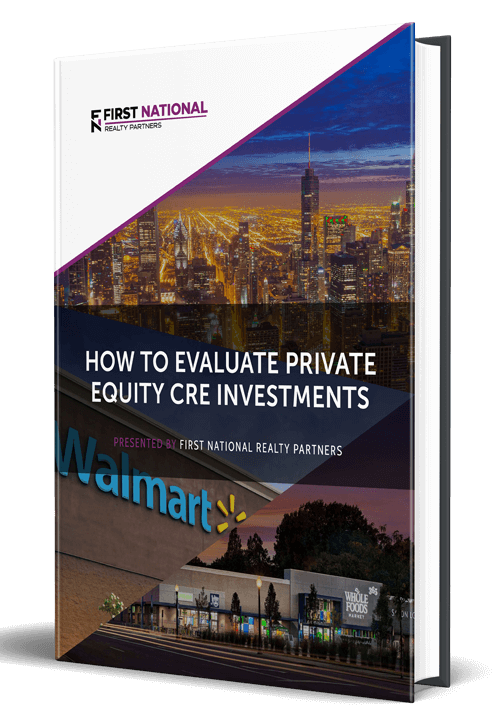Often, 1031 Exchange transactions are presented as relatively straightforward – and in many cases they are – but some investors may not realize that there are fairly strict timelines under which the exchange needs to occur. This may change the calculus of a deal.
In this article, we are going to discuss what a 1031 Exchange is and the timelines under which they need to be executed. By the end, readers will have the information needed to determine if a 1031 Exchange is a good fit for their own needs given the time constraints involved.
At First National Realty Partners, we specialize in the acquisition and management of grocery store anchored retail centers. If you are an accredited investor and would like to learn more about our current opportunities, click here.
What is a 1031 Exchange?
Before discussing timelines, it makes sense to describe what a 1031 Exchange is more generally.
A 1031 Exchange is a type of commercial real estate transaction that allows investors to defer capital gains taxes on the profitable sale of an investment property – as long as the sale proceeds are reinvested into a new property that is “like kind” to the one that was sold.
The rules for completing a 1031 Exchange are described in section 1031 of the Internal Revenue Code (IRC). The key points include:
- The property must be held for “productive use in a trade or for business or investment.”
- The taxpayer must be the same for both properties
- The debt and equity in the sold property must be equal to or greater than the debt and equity in the new property
- The property cannot be held primarily for sale
In addition to these requirements, there is also a very explicit timeline that investors must follow to achieve full tax deferral.
1031 Exchanges Follow a Strict Timeline
There are three key dates/exchange deadlines that investors must be aware of when completing a 1031 Exchange.
The Sale Date
The first date is the sale date, which is the date that the investor sells their property – known as the relinquished property. The closing date of the sale puts investors on the clock to begin the process of finding a new property.
45 Day Identification Period
From the date of sale of the relinquished property, investors have 45 calendar days to find a suitable “replacement property.” The chosen property must meet a few criteria:
- The replacement property must be “like kind” to the one that was sold. In general, most commercial property is like kind to other commercial property. For example, real estate investors could exchange a retail property for a multifamily apartment building or office building. However, they are unable to use their primary residence or vacation home except with rare exceptions.
- The value of the replacement property must be equal to or greater than the one that was sold. The debt and equity in the replacement property must also be equal to or greater than the sold property. So, for example, if an investor sold a property for $1,000,000 and it had $500,000 in debt, the new property must have a fair market value of at least $1,000,000 and at least $500,000 in debt.
- The three property rule states that Investors can identify up to three potential replacement properties as long as they close on at least one of them.
- Or, investors can identify as many replacement properties as they want, as long as their total aggregate value does not exceed 200% of the value of the relinquished property.
Replacement properties are formally identified, in writing, with their legal description in a document provided by the Qualified Intermediary assisting with the transaction.
So, given all of these criteria, finding a replacement property by the 45th day can be a challenge.
180 Day Exchange Period
The third major date to remember is 180 days.
Property owners have 180 days from the relinquished property sale date to close on the purchase of the replacement property.
Or, put another way, they have an additional 135 days from the identification of the replacement property to close on the purchase.
Again, this is a relatively short amount of time to complete all of the necessary tasks to get a property to a close, including completing due diligence and arranging financing.
Disaster Relief
IRS Revenue Procedure 2018-58 provides investors with an extension of these timeline requirements if a property is located in a federally declared disaster area. The exact relief is somewhat dependent upon the transaction specifics and the guidelines described in the revenue procedure, but it could be up to 120 days.
To read the specifics of the revenue procedure, click here.
What Happens If An Investor Does Not Identify a Property On Time?
Again, the specifics of every transaction can result in a slightly different outcome, but the risk of a violation of exchange rules is that some or all of the realized gain loses its tax deferral status – which will be determined when investors go to file their income tax return for the relevant tax year.
Again, a 1031, delayed exchange transaction can be a complex one, which highlights the need to work with a qualified intermediary (sometimes called an exchange accommodation titleholder) and/or get qualified legal advice, to ensure that all rules are followed.
Alternatives to Consider
Because the 1031 exchange timeline can be aggressive and because some investors may not necessarily have to purchase an entire property, there are two fractional ownership alternatives to a 1031 exchange that may be considered.
The first is a structure known as a Delaware Statutory Trust (DST), which is a trust set up under Delaware law. Typically, the trust will be used to purchase a property and shares in the trust are sold to investors. In return for their capital, investors receive their proportionate share of the income and profits produced by the underlying asset.
The other option is known as a tenants in common (TIC) ownership structure, which allows an investor to directly purchase a fractional share of an institutional quality asset. Likewise, investors are entitled to their proportionate share of income and profits produced by the underlying property.
IRS and property identification rules allow both options to be used as a replacement property in a 1031 exchange. The key benefits of doing so are speed, flexibility, and passive income because both of these options are managed by a third party, professional firm.
Summary of 1031 Exchange Time Frames
A 1031, like-kind exchange is a time sensitive transaction and there are three important dates for investors to remember.
The first is the sale date of the relinquished property. Consider this to be “day 0” as it starts the clock for the other deadlines in the transaction.
The second is day 45, by which time investors are required to formally identify their replacement property. Identification must follow a series of rules regarding the price and planned use.
The third is the 180th day, by which time investors are required to complete their purchase of the identified properties.
Failure to comply with the required timelines could result in the exclusion of some or all of the tax deferred transaction, which can be very expensive.
There are two alternatives that can be used to make the exchange process a bit easier – the Delaware Statutory Trust and the Tenants In Common structure. In both cases, the property qualifies as a suitable replacement, but they are faster and easier to find.
Interested In Learning More?
First National Realty Partners is one of the country’s leading private equity commercial real estate investment firms. With an intentional focus on finding world-class, multi-tenanted assets well below intrinsic value, we seek to create superior long-term, risk-adjusted returns for our investors while creating strong economic assets for the communities we invest in.
If you are an Accredited Real Estate Investor and want to learn more about our investment opportunities, contact us at (800) 605-4966 or info@fnrpusa.com for more information.






